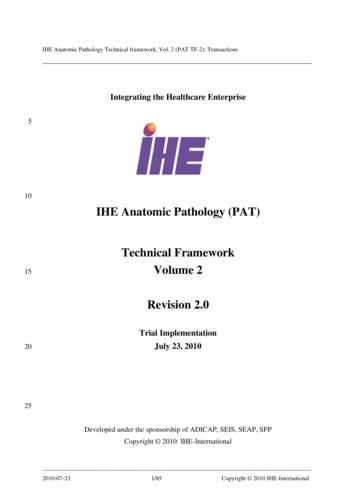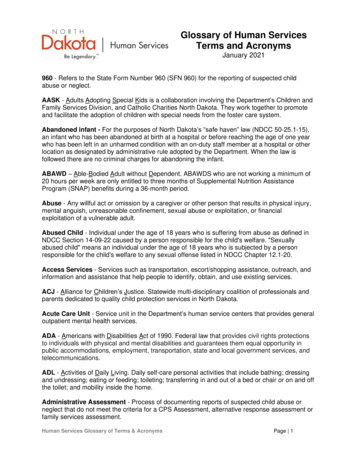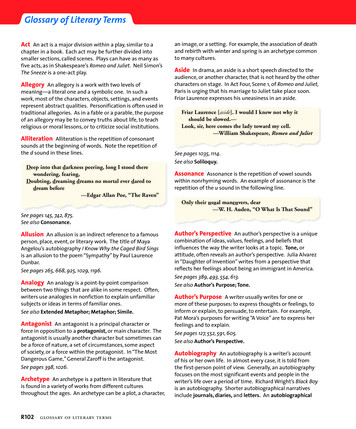
Transcription
Glossary of Radiological TermsAbsolute risk: the proportion of a population expected to get a disease over a specified time period. Seealso risk, relative risk.Absorbed dose: the amount of energy deposited by ionizing radiation in a unit mass of tissue. It isexpressed in units of joule per kilogram (J/kg), and called “gray” (Gy). For more information, see “Primeron Radiation Measurement” at the end of this document.Activity (radioactivity): the rate of decay of radioactive material expressed as the number of atomsbreaking down per second measured in units called becquerels or curies.Acute exposure: an exposure to radiation that occurred in a matter of minutes rather than in longer,continuing exposure over a period of time. See also chronic exposure, exposure, fractionated exposure.Acute Radiation Syndrome (ARS): a serious illness caused by receiving a dose greater than 50 rads ofpenetrating radiation to the body in a short time (usually minutes). The earliest symptoms are nausea,fatigue, vomiting, and diarrhea. Hair loss, bleeding, swelling of the mouth and throat, and general loss ofenergy may follow. If the exposure has been approximately 1,000 rads or more, death may occur within 2– 4 weeks. For more information, see CDC’s fact sheet “Acute Radiation Syndrome” athttp://www.bt.cdc.gov/radiation/ars.asp.Air burst: a nuclear weapon explosion that is high enough in the air to keep the fireball from touching theground. Because the fireball does not reach the ground and does not pick up any surface material, theradioactivity in the fallout from an air burst is relatively insignificant compared with a surface burst. Formore information, see Chapter 2 of CDC’s Fallout Report treport.pdf.Alpha particle: the nucleus of a helium atom, made up of two neutrons and two protons with a charge of 2. Certain radioactive nuclei emit alpha particles. Alpha particles generally carry more energy thangamma or beta particles, and deposit that energy very quickly while passing through tissue. Alphaparticles can be stopped by a thin layer of light material, such as a sheet of paper, and cannot penetratethe outer, dead layer of skin. Therefore, they do not damage living tissue when outside the body. Whenalpha-emitting atoms are inhaled or swallowed, however, they are especially damaging because theytransfer relatively large amounts of ionizing energy to living cells. See also beta particle, gamma ray,neutron, x-ray.Ambient air: the air that surrounds us.Americium (Am): a silvery metal; it is a man-made element whose isotopes Am-237 through Am-246are all radioactive. Am-241 is formed spontaneously by the beta decay of plutonium-241. Trace quantitiesof americium are widely used in smoke detectors, and as neutron sources in neutron moisture gauges.Atom: the smallest particle of an element that can enter into a chemical reaction.Atomic number: the total number of protons in the nucleus of an atom.Page 1 of 16
Glossary of Radiological Terms(continued from previous page)Atomic mass unit (amu): 1 amu is equal to one twelfth of the mass of a carbon-12 atom.Atomic mass number: the total number of protons and neutrons in the nucleus of an atom.Atomic weight: the mass of an atom, expressed in atomic mass units. For example, the atomic numberof helium-4 is 2, the atomic mass is 4, and the atomic weight is 4.00026.Background radiation: ionizing radiation from natural sources, such as terrestrial radiation due toradionuclides in the soil or cosmic radiation originating in outer space.Becquerel (Bq): the amount of a radioactive material that will undergo one decay (disintegration) persecond. For more information, see “Primer on Radiation Measurement” at the end of this document.Beta particles: electrons ejected from the nucleus of a decaying atom. Although they can be stopped bya thin sheet of aluminum, beta particles can penetrate the dead skin layer, potentially causing burns. Theycan pose a serious direct or external radiation threat and can be lethal depending on the amount received.They also pose a serious internal radiation threat if beta-emitting atoms are ingested or inhaled. See alsoalpha particle, gamma ray, neutron, x-ray.Bioassay: an assessment of radioactive materials that may be present inside a person’s body throughanalysis of the person’s blood, urine, feces, or sweat.Biological Effects of Ionizing Radiation (BEIR) Reports: reports of the National Research Council'scommittee on the Biological Effects of Ionizing Radiation. For more information, gical half-life: the time required for one half of the amount of a substance, such as a radionuclide,to be expelled from the body by natural metabolic processes, not counting radioactive decay, once it hasbeen taken in through inhalation, ingestion, or absorption. See also radioactive half-life, effective half-life.Carcinogen: a cancer-causing substance.Chain reaction: a process that initiates its own repetition. In a fission chain reaction, a fissile nucleusabsorbs a neutron and fissions (splits) spontaneously, releasing additional neutrons. These, in turn, can beabsorbed by other fissile nuclei, releasing still more neutrons. A fission chain reaction is self-sustainingwhen the number of neutrons released in a given time equals or exceeds the number of neutrons lost byabsorption in non-fissile material or by escape from the system.Chronic exposure: exposure to a substance over a long period of time, possibly resulting in adversehealth effects. See also acute exposure, fractionated exposure.Cobalt (Co): gray, hard, magnetic, and somewhat malleable metal. Cobalt is relatively rare and generallyobtained as a byproduct of other metals, such as copper. Its most common radioisotope, cobalt-60 (Co60), is used in radiography and medical applications. Cobalt-60 emits beta particles and gamma raysduring radioactive decay.Collective dose: the estimated dose for an area or region multiplied by the estimated population in thatarea or region. For more information, see “Primer on Radiation Measurement” at the end of thisdocument.August 2004Page 2 of 16
Glossary of Radiological Terms(continued from previous page)Committed dose: a dose that accounts for continuing exposures expected to be received over a longperiod of time (such as 30, 50, or 70 years) from radioactive materials that were deposited inside thebody. For more information, see “Primer on Radiation Measurement” at the end of this document.Concentration: the ratio of the amount of a specific substance in a given volume or mass of solution tothe mass or volume of solvent.Conference of Radiation Control Program Directors (CRCPD): an organization whose membersrepresent state radiation protection programs. For more information, see the CRCPD website:http://www.crcpd.org.Contamination (radioactive): the deposition of unwanted radioactive material on the surfaces ofstructures, areas, objects, or people where it may be external or internal. See also decontamination.Cosmic radiation: radiation produced in outer space when heavy particles from other galaxies (nuclei ofall known natural elements) bombard the earth. See also background radiation, terrestrial radiation.Criticality: a fission process where the neutron production rate equals the neutron loss rate to absorptionor leakage. A nuclear reactor is "critical" when it is operating.Critical mass: the minimum amount of fissile material that can achieve a self-sustaining nuclear chainreaction.Cumulative dose: the total dose resulting from repeated or continuous exposures of the same portion ofthe body, or of the whole body, to ionizing radiation. For more information, see “Primer on RadiationMeasurement” at the end of this document.Curie (Ci): the traditional measure of radioactivity based on the observed decay rate of 1 gram ofradium. One curie of radioactive material will have 37 billion disintegrations in 1 second. For moreinformation, see “Primer on Radiation Measurement” at the end of this document.Cutaneous Radiation Syndrome (CRS): the complex syndrome resulting from radiation exposure ofmore than 200 rads to the skin. The immediate effects can be reddening and swelling of the exposed area(like a severe burn), blisters, ulcers on the skin, hair loss, and severe pain. Very large doses can result inpermanent hair loss, scarring, altered skin color, deterioration of the affected body part, and death of theaffected tissue (requiring surgery). For more information, see CDC’s fact sheet “Acute RadiationSyndrome,” at http://www.bt.cdc.gov/radiation/ars.asp.Decay chain (decay series): the series of decays that certain radioisotopes go through before reachinga stable form. For example, the decay chain that begins with uranium-238 (U-238) ends in lead-206 (Pb206), after forming isotopes, such as uranium-234 (U-234), thorium-230 (Th-230), radium-226 (Ra-226),and radon-222 (Rn-222).Decay constant: the fraction of a number of atoms of a radioactive nuclide that disintegrates in a unit oftime. The decay constant is inversely proportional to the radioactive half-life.Decay products (or daughter products): the isotopes or elements formed and the particles and highenergy electromagnetic radiation emitted by the nuclei of radionuclides during radioactive decay. Alsoknown as "decay chain products" or "progeny" (the isotopes and elements). A decay product may beeither radioactive or stable.August 2004Page 3 of 16
Glossary of Radiological Terms(continued from previous page)Decay, radioactive: disintegration of the nucleus of an unstable atom by the release of radiation.Decontamination: the reduction or removal of radioactive contamination from a structure, object, orperson.Depleted uranium: uranium containing less than 0.7% uranium-235, the amount found in naturaluranium. See also enriched uranium.Deposition density: the activity of a radionuclide per unit area of ground. Reported as becquerels persquare meter or curies per square meter.Deterministic effects: effects that can be related directly to the radiation dose received. The severityincreases as the dose increases. A deterministic effect typically has a threshold below which the effect willnot occur. See also stochastic effect, non-stochastic effect.Deuterium: a non-radioactive isotope of the hydrogen atom that contains a neutron in its nucleus inaddition to the one proton normally seen in hydrogen. A deuterium atom is twice as heavy as normalhydrogen. See also tritium.Dirty bomb: a device designed to spread radioactive material by conventional explosives when the bombexplodes. A dirty bomb kills or injures people through the initial blast of the conventional explosive andspreads radioactive contamination over possibly a large area—hence the term “dirty.” Such bombs couldbe miniature devices or large truck bombs. A dirty bomb is much simpler to make than a true nuclearweapon. See also radiological dispersal device.Dose (radiation): radiation absorbed by person’s body. Several different terms describe radiation dose.For more information, see “Primer on Radiation Measurement” at the end of this document.Dose coefficient: the factor used to convert radionuclide intake to dose. Usually expressed as dose perunit intake (e.g., sieverts per becquerel).Dose equivalent: a quantity used in radiation protection to place all radiation on a common scale forcalculating tissue damage. Dose equivalent is the absorbed dose in grays times the quality factor. Thequality factor accounts for differences in radiation effects caused by different types of ionizing radiation.Some radiation, including alpha particles, causes a greater amount of damage per unit of absorbed dosethan other radiation. The sievert (Sv) is the unit used to measure dose equivalent. For more information,see “Primer on Radiation Measurement” at the end of this document.Dose rate: the radiation dose delivered per unit of time.Dose reconstruction: a scientific study that estimates doses to people from releases of radioactivity orother pollutants. The dose is reconstructed by determining the amount of material released, the waypeople came in contact with it, and the amount they absorbed.Dosimeter: a small portable instrument (such as a film badge, thermoluminescent dosimeter [TLD], orpocket dosimeter) for measuring and recording the total accumulated dose of ionizing radiation a personreceives.Dosimetry: assessment (by measurement or calculation) of radiation dose.August 2004Page 4 of 16
Glossary of Radiological Terms(continued from previous page)Effective dose: a dosimetric quantity useful for comparing the overall health affects of irradiation of thewhole body. It takes into account the absorbed doses received by various organs and tissues and weighsthem according to present knowledge of the sensitivity of each organ to radiation. It also accounts for thetype of radiation and the potential for each type to inflict biologic damage. The effective dose is used, forexample, to compare the overall health detriments of different radionuclides in a given mix. The unit ofeffective dose is the sievert (Sv); 1 Sv 1 J/kg. For more information, see “Primer on RadiationMeasurement” at the end of this document.Effective half-life: the time required for the amount of a radionuclide deposited in a living organism tobe diminished by 50% as a result of the combined action of radioactive decay and biologic elimination.See also biological half-life, decay constant, radioactive half-life.Electron: an elementary particle with a negative electrical charge and a mass 1/1837 that of the proton.Electrons surround the nucleus of an atom because of the attraction between their negative charge andthe positive charge of the nucleus. A stable atom will have as many electrons as it has protons. Thenumber of electrons that orbit an atom determine its chemical properties. See also neutron.Electron volt (eV): a unit of energy equivalent to the amount of energy gained by an electron when itpasses from a point of low potential to a point one volt higher in potential.Element: 1) all isotopes of an atom that contain the same number of protons. For example, the elementuranium has 92 protons, and the different isotopes of this element may contain 134 to 148 neutrons. 2)In a reactor, a fuel element is a metal rod containing the fissile material.Enriched uranium: uranium in which the proportion of the isotope uranium-235 has been increased byremoving uranium-238 mechanically. See also depleted uranium.Epidemiology: the study of the distribution and determinants of health-related states or events inspecified populations; and the application of this study to the control of health problems.Exposure (radiation): a measure of ionization in air caused by x-rays or gamma rays only. The unit ofexposure most often used is the roentgen. See also contamination.Exposure pathway: a route by which a radionuclide or other toxic material can enter the body. The mainexposure routes are inhalation, ingestion, absorption through the skin, and entry through a cut or woundin the skin.Exposure rate: a measure of the ionization produced in air by x-rays or gamma rays per unit of time(frequently expressed in roentgens per hour).External exposure: exposure to radiation outside of the body.Fallout, nuclear: minute particles of radioactive debris that descend slowly from the atmosphere after anuclear explosion. For more information, see Chapter 2 of CDC’s Fallout Report treport.pdf.Fissile material: any material in which neutrons can cause a fission reaction. The three primary fissilematerials are uranium-233, uranium-235, and plutonium-239.Fission (fissioning): the splitting of a nucleus into at least two other nuclei that releases a large amountof energy. Two or three neutrons are usually released during this transformation. See also fusion.August 2004Page 5 of 16
Glossary of Radiological Terms(continued from previous page)Fractionated exposure: exposure to radiation that occurs in several small acute exposures, rather thancontinuously as in a chronic exposure.Fusion: a reaction in which at least one heavier, more stable nucleus is produced from two lighter, lessstable nuclei. Reactions of this type are responsible for the release of energy in stars or in thermonuclearweapons.Gamma rays: high-energy electromagnetic radiation emitted by certain radionuclides when their nucleitransition from a higher to a lower energy state. These rays have high energy and a short wave length. Allgamma rays emitted from a given isotope have the same energy, a characteristic that enables scientiststo identify which gamma emitters are present in a sample. Gamma rays penetrate tissue farther than dobeta or alpha particles, but leave a lower concentration of ions in their path to potentially cause celldamage. Gamma rays are very similar to x-rays. See also neutron.Geiger counter: a radiation detection and measuring instrument consisting of a gas-filled tube containingelectrodes, between which an electrical voltage but no current flows. When ionizing radiation passesthrough the tube, a short, intense pulse of current passes from the negative electrode to the positiveelectrode and is measured or counted. The number of pulses per second measures the intensity of theradiation field. Geiger counters are the most commonly used portable radiation detection instruments.Genetic effects: hereditary effects (mutations) that can be passed on through reproduction because ofchanges in sperm or ova. See also teratogenic effects, somatic effects.Gray (Gy): a unit of measurement for absorbed dose. It measures the amount of energy absorbed in amaterial. The unit Gy can be used for any type of radiation, but it does not describe the biological effectsof the different radiations. For more information, see “Primer on Radiation Measurement” at the end ofthis document.Half-life: the time any substance takes to decay by half of its original amount. See also biological halflife, decay constant, effective half-life, radioactive half-life.Health physics: a scientific field that focuses on protection of humans and the environment fromradiation. Health physics uses physics, biology, chemistry, statistics, and electronic instrumentation tohelp protect individuals from any damaging effects of radiation. For more information, see the HealthPhysics Society website: http://www.hps.org/.High-level radioactive waste: the radioactive material resulting from spent nuclear fuel reprocessing.This can include liquid waste directly produced in reprocessing or any solid material derived from the liquidwastes having a sufficient concentration of fission products. Other radioactive materials can be designatedas high-level waste, if they require permanent isolation. This determination is made by the U.S. NuclearRegulatory Commission on the basis of criteria established in U.S. law. See also low-level waste,transuranic waste.Hot spot: any place where the level of radioactive contamination is considerably greater than the areaaround it.Ingestion: 1) the act of swallowing; 2) in the case of radionuclides or chemicals, swallowing radionuclidesor chemicals by eating or drinking.Inhalation: 1) the act of breathing in; 2) in the case of radionuclides or chemicals, breathing inradionuclides or chemicals.August 2004Page 6 of 16
Glossary of Radiological Terms(continued from previous page)Internal exposure: exposure to radioactive material taken into the body.Iodine: a nonmetallic solid element. There are both radioactive and non-radioactive isotopes of iodine.Radioactive isotopes of iodine are widely used in medical applications. Radioactive iodine is a fissionproduct and is the largest contributor to people’s radiation dose after an accident at a nuclear reactor.Ion: an atom that has fewer or more electrons than it has protons causing it to have an electrical chargeand, therefore, be chemically reactive.Ionization: the process of adding one or more electrons to, or removing one or more electrons from,atoms or molecules, thereby creating ions. High temperatures, electrical discharges, or nuclear radiationcan cause ionization.Ionizing radiation: any radiation capable of displacing electrons from atoms, thereby producing ions.High doses of ionizing radiation may produce severe skin or tissue damage. See also alpha particle, betaparticle, gamma ray, neutron, x-ray.Irradiation: exposure to radiation.Isotope: a nuclide of an element having the same number of protons but a different number of neutrons.Kiloton (Kt): the energy of an explosion that is equivalent to an explosion of 1,000 tons of TNT. Onekiloton equals 1 trillion (1012) calories. See also megaton.Latent period: the time between exposure to a toxic material and the appearance of a resultant healtheffect.Lead (Pb): a heavy metal. Several isotopes of lead, such as Pb-210 which emits beta radiation, are in theuranium decay chain.Lead Federal Agency (LFA): the federal agency that leads and coordinates the emergency responseactivities of other federal agencies during a nuclear emergency. After a nuclear emergency, the FederalRadiological Emergency Response Plan (FRERP, available nal/frerp.htm) will determine which federal agency willbe the LFA.Local radiation injury (LRI): acute radiation exposure (more than 1,000 rads) to a small, localized partof the body. Most local radiation injuries do not cause death. However, if the exposure is from penetratingradiation (neutrons, x-rays, or gamma rays), internal organs may be damaged and some symptoms ofacute radiation syndrome (ARS), including death, may occur. Local radiation injury invariably involves skindamage, and a skin graft or other surgery may be required. See also CDC’s fact sheet “Acute RadiationSyndrome” at http://www.bt.cdc.gov/radiation/ars.asp.Low-level waste (LLW): radioactively contaminated industrial or research waste such as paper, rags,plastic bags, medical waste, and water-treatment residues. It is waste that does not meet the criteria forany of three other categories of radioactive waste: spent nuclear fuel and high-level radioactive waste;transuranic radioactive waste; or uranium mill tailings. Its categorization does not depend on the level ofradioactivity it contains.August 2004Page 7 of 16
Glossary of Radiological Terms(continued from previous page)Megaton (Mt): the energy of an explosion that is equivalent to an explosion of 1 million tons of TNT. Onemegaton is equal to a quintillion (1018) calories. See also kiloton.Molecule: a combination of two or more atoms that are chemically bonded. A molecule is the smallestunit of a compound that can exist by itself and retain all of its chemical properties.Neoplastic: pertaining to the pathologic process resulting in the formation and growth of an abnormalmass of tissue.Neutron: a small atomic particle possessing no electrical charge typically found within an atom's nucleus.Neutrons are, as the name implies, neutral in their charge. That is, they have neither a positive nor anegative charge. A neutron has about the same mass as a proton. See also alpha particle, beta particle,gamma ray, nucleon, x-ray.Non-ionizing radiation: radiation that has lower energy levels and longer wavelengths than ionizingradiation. It is not strong enough to affect the structure of atoms it contacts but is strong enough to heattissue and can cause harmful biological effects. Examples include radio waves, microwaves, visible light,and infrared from a heat lamp.Non-stochastic effects: effects that can be related directly to the radiation dose received. The effect ismore severe with a higher does. It typically has a threshold, below which the effect will not occur. Theseare sometimes called deterministic effects. For example, a skin burn from radiation is a non-stochasticeffect that worsens as the radiation dose increases. See also stochastic effects.Nuclear energy: the heat energy produced by the process of nuclear fission within a nuclear reactor orby radioactive decay.Nuclear fuel cycle: the steps involved in supplying fuel for nuclear power plants. It can include mining,milling, isotopic enrichment, fabrication of fuel elements, use in reactors, chemical reprocessing to recoverthe fissile material remaining in the spent fuel, reenrichment of the fuel material refabrication into newfuel elements, and waste disposal.Nuclear tracers: radioisotopes that give doctors the ability to "look" inside the body and observe softtissues and organs, in a manner similar to the way x-rays provide images of bones. A radioactive tracer ischemically attached to a compound that will concentrate naturally in an organ or tissue so that an imagecan be taken.Nucleon: a proton or a neutron; a constituent of the nucleus of an atom.Nucleus: the central part of an atom that contains protons and neutrons. The nucleus is the heaviest partof the atom.Nuclide: a general term applicable to all atomic forms of an element. Nuclides are characterized by thenumber of protons and neutrons in the nucleus, as well as by the amount of energy contained within theatom.Pathways: the routes by which people are exposed to radiation or other contaminants. The three basicpathways are inhalation, ingestion, and direct external exposure. See also exposure pathway.August 2004Page 8 of 16
Glossary of Radiological Terms(continued from previous page)Penetrating radiation: radiation that can penetrate the skin and reach internal organs and tissues.Photons (gamma rays and x-rays), neutrons, and protons are penetrating radiations. However, alphaparticles and all but extremely high-energy beta particles are not considered penetrating radiation.Photon: discrete "packet" of pure electromagnetic energy. Photons have no mass and travel at the speedof light. The term "photon" was developed to describe energy when it acts like a particle (causinginteractions at the molecular or atomic level), rather than a wave. Gamma rays and x-rays are photons.Pitchblende: a brown to black mineral that has a distinctive luster. It consists mainly of urananite (UO2),but also contains radium (Ra). It is the main source of uranium (U) ore.Plume: the material spreading from a particular source and traveling through environmental media, suchas air or ground water. For example, a plume could describe the dispersal of particles, gases, vapors, andaerosols in the atmosphere, or the movement of contamination through an aquifer (For example, dilution,mixing, or adsorption onto soil).Plutonium (Pu): a heavy, man-made, radioactive metallic element. The most important isotope is Pu239, which has a half-life of 24,000 years. Pu-239 can be used in reactor fuel and is the primary isotope inweapons. One kilogram is equivalent to about 22 million kilowatt-hours of heat energy. The completedetonation of a kilogram of plutonium produces an explosion equal to about 20,000 tons of chemicalexplosive. All isotopes of plutonium are readily absorbed by the bones and can be lethal depending on thedose and exposure time.Polonium (Po): a radioactive chemical element and a product of radium (Ra) decay. Polonium is found inuranium (U) ores.Prenatal radiation exposure: radiation exposure to an embryo or fetus while it is still in its mother’swomb. At certain stages of the pregnancy, the fetus is particularly sensitive to radiation and the healthconsequences could be severe above 5 rads, especially to brain function. For more information, see CDC’sfact sheet, “Possible Health Effects of Radiation Exposure on Unborn Babies,” tective Action Guide (PAG): a guide that tells state and local authorities at what projected dosethey should take action to protect people from exposure to unplanned releases of radioactive material intothe environment.Proton: a small atomic particle, typically found within an atom's nucleus, that possesses a positiveelectrical charge. Even though protons and neutrons are about 2,000 times heavier than electrons, theyare tiny. The number of protons is unique for each chemical element. See also nucleon.Quality factor (Q): the factor by which the absorbed dose (rad or gray) is multiplied to obtain a quantitythat expresses, on a common scale for all ionizing radiation, the biological damage (rem) to an exposedperson. It is used because some types of radiation, such as alpha particles, are more biologicallydamaging internally than other types. For more information, see “Primer on Radiation Measurement” atthe end of this document.Rad (radiation absorbed dose): a basic unit of absorbed radiation dose. It is a measure of the amountof energy absorbed by the body. The rad is the traditional unit of absorbed dose. It is being replaced bythe unit gray (Gy), which is equivalent to 100 rad. One rad equals the dose delivered to an object of 100ergs of energy per gram of material. For more information, see “Primer on Radiation Measurement” at theend of this document.August 2004Page 9 of 16
Glossary of Radiological Terms(continued from previous page)Radiation: energy moving in the form of particles or waves. Familiar radiations are heat, light, radiowaves, and microwaves. Ionizing radiation is a very high-energy form of electromagnetic radiation.Radiation sickness: See also acute radiation syndrome (ARS), or the CDC fact sheet “Acute RadiationSyndrome,” at http://www.bt.cdc.gov/radiation/ars.asp.Radiation warning symbol: a symbol prescribed by the Code of Federal Regulations. It isa magenta or black trefoil on a yellow background. It must be displayed where certainquantities of radioactive materials are present or where certain doses of radiation could bereceived.Radioactive contamination: the deposition of unwanted radioactive material on the surfaces ofstructures, areas, objects, or people. It can be airborne, external, or internal. See al
Glossary of Radiological Terms (continued from previous page) August 2004 Page 2 of 16 Atomic mass unit (amu): 1 amu is equal to one twelfth of the mass of a carbon-12 atom. Atomic mass number: the total number of protons and neutrons in the nucleus of an atom. Atomic weight: the mass of an atom, expressed in atomic mass units. For example, the atomic number










